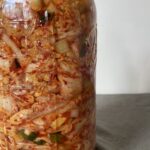
Classic Kimchi
Kimchi is spicy, sour, crunchy, and umami. It's an iconic fermented dish that's easy to make at home. Learn how to make it step by step and change the heat to your liking.
Equipment
- Vegetable grater
- Mortar & pestle
- Bus tub
- 1/2 gallon canning jar + 1 quart canning jar
- Fermentation weight
Ingredients
- 5 lbs Napa cabbage, cored and sliced into 1" x 2" pieces
- 5 tbsp unrefined sea salt, divided
- 8 tbsp gochugaru
- 6 cloves garlic, chopped
- 10 oz daikon radish, peeled and chopped into small pieces
- 10 stalks green onions, chopped
- 2 tbsp grated ginger
- 4 tbsp coconut sugar
Instructions
Day 1
- Wash all your vegetables, bus tub, and fermentation container(s).
- Put the cabbage in a bus tub and add 3 tbsp of sea salt.
- Massage the salt in with your hands for a couple of minutes. Set aside for 30-60 minutes.
- Place 2 tbsp of sea salt, gochugaru, and garlic into a mortar and pestle. Grind until a paste is formed.
- Add the gochugaru mix, daikon radish, green onions, ginger, and coconut sugar to the cabbage mix. Mix well.
- Pack the kimchi mixture, including the liquid that has been released, into a jar or crock. Firmly pack down the cabbage mixture and place your weight.
- Let it ferment in a cool spot away from direct sunlight.
Day 2
- Check the brine. It may have increased overnight. If it does, pour off extra brine so that it doesn’t overflow. Check it again later in the day to make sure the brine didn’t rise back up. Pour off any extra.
- Give it a visual check every day.
Day 3
- Expect to see bubbles rising up through the brine and maybe foam on top.
- Give it a visual check every day.
Day 7-28
- You may notice less activity and no foam or bubbles. This is normal!
- Give it a try to see how you like it. More time = more tang. If you want it to keep fermenting longer, place everything back under the brine and keep it at room temp for a few more days. If you’re happy with it, put a label on the jar with the name and date of your ferment. Top the jar with a plastic lid and place it in the fridge.
For storage
- Once fermented to your liking, place kimchi in the fridge with an airtight lid. Look for plastic jar lids because they won’t rust. If you’re fermenting in a crock, decant finished kimchi into glass jars for easier storage in the fridge.
Notes
Use a fermentation weight. These sit right on top of the vegetables to keep the veggies underneath the brine. They’re a simple and non-toxic way to do fermentation at home. You can also use a fermentation device, like Kraut Source. It pushes down on the vegetables to make sure they stay beneath their brine.
Watch for signs of fermentation. This usually starts on day 2 and peaks on day 3. You might see foam at the top or bubbles rippling through the brine. This is a good sign! It means healthy bacteria are there doing their job.
Save the brine. For a potent probiotic punch, sip the brine with lunch or use it to replace the vinegar in your favorite salad dressing.